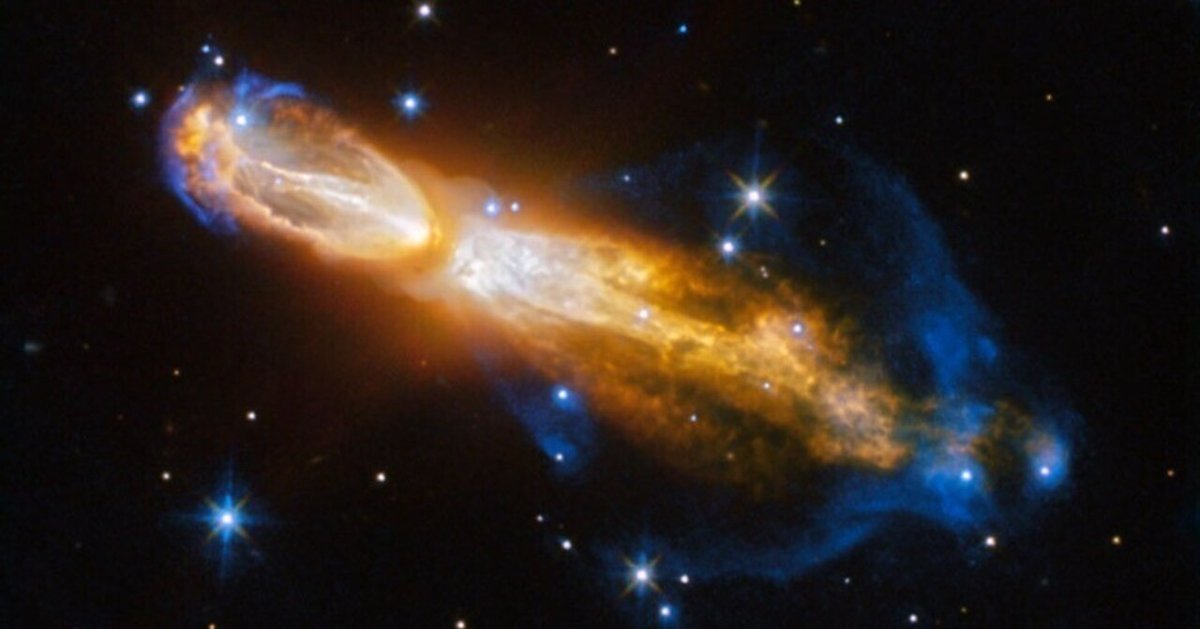
ひょうたん星雲

これは、ひょうたん星雲、または腐った卵星雲(ひどい名前だ)と名付けられているOH231.8+4.2という星雲。地球から、とも座方向5000光年のところにあり、1.4光年の大きさがある。
これは、ひょうたんの首に当たるところにある、星が白色矮星になる過程で、放出したエネルギーが、星の表層を吹き飛ばし、時速100万Kmに達するガスを放出している。
それが、周辺のガスと衝突して、衝撃波を発生させ、それによってイオン化された水素と酸素が青く光っているのです。
このような状態を原始惑星状星雲という。
今後、この星雲は、1000年ほどで、双極惑星状星雲になるものと考えられている。
では、双極惑星状星雲とは、どんなものか。

これは、蝶の羽星雲と呼ばれる、M2-9星雲である。
見るように、中心星から双極(北極と南極)方向に、ガスを放出している。
中心の星は、太陽程度の低質量の星が、核融合を起こす燃料である水素を消費し尽くして、白色矮星になっている。
この中心には、冥王星の10倍のガスの円盤の中を、2つ星が回っている、いわゆる連星になっている。このような場合、連星の公転面に対して、垂直方向にガスを噴き出す現象が起きる。
そこで、このような、双極を持った形になる。
と考えられている。
ところで、この双極惑星状星雲に面白いことが、分かった。
天の川銀河のバルジ(銀河の中心のレンズのようなところ)にある130個の双極惑星状星雲うち44個が、銀河面の方向に伸びていたのだ。
となると、これらの連星の公転面は、銀河面に対して垂直方向だということになる。
ほほう、天の川銀河の渦と垂直方向の面をお互いに回っているのか・・・
普通は、渦と同じ平面を回るはずなんだが・・・
銀河中心部の星は、我々の太陽よりも、古く100億年前後の星が多い。天の川銀河ができた頃は、現在と違った力が働いていたのではないか、と考えられているのだ。
M2-9: Wings of a Butterfly Nebula
Image Credit: Hubble Legacy Archive, NASA, ESA - Processing: Judy Schmidt
Explanation: Are stars better appreciated for their art after they die? Actually, stars usually create their most artistic displays as they die. In the case of low-mass stars like our Sun and M2-9 pictured above, the stars transform themselves from normal stars to white dwarfs by casting off their outer gaseous envelopes. The expended gas frequently forms an impressive display called a planetary nebula that fades gradually over thousands of years. M2-9, a butterfly planetary nebula 2100 light-years away shown in representative colors, has wings that tell a strange but incomplete tale. In the center, two stars orbit inside a gaseous disk 10 times the orbit of Pluto. The expelled envelope of the dying star breaks out from the disk creating the bipolar appearance. Much remains unknown about the physical processes that cause planetary nebulae.
サポートしていただけるなんて、金額の多寡に関係なく、記事発信者冥利に尽きます。
